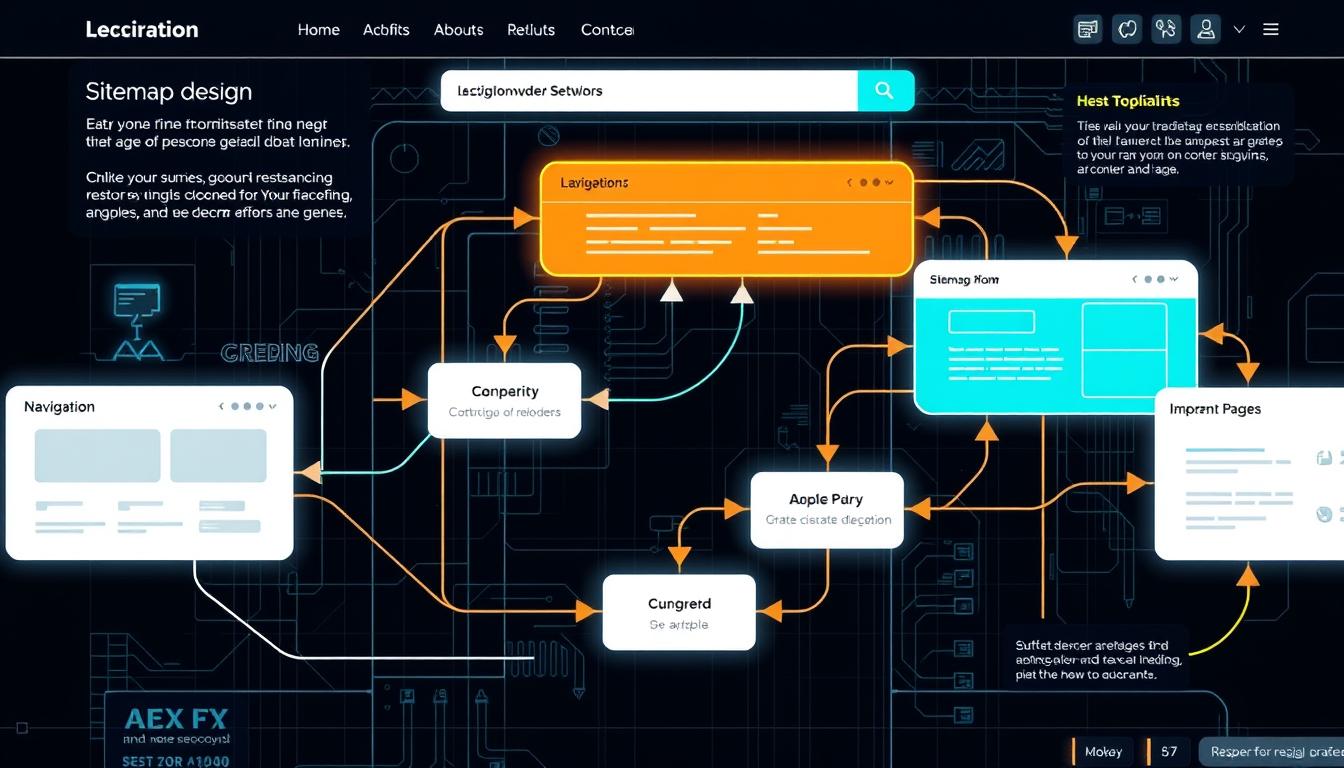Did you know that over 90% of web pages garner zero organic traffic from Google? This astonishing figure underscores the paramount significance of optimizing site architecture for crawlability. Efficient crawling by search engines enhances visibility, thereby boosting SEO performance. A meticulously planned site structure significantly elevates your ranking potential in search results.
In this article, we will explore the pivotal elements contributing to a crawl-friendly website design. Grasping the fundamentals of site structure optimization is crucial for ensuring search engines can effectively index your content. For a more in-depth look at site architecture, refer to this comprehensive guide. Let us embark on a detailed examination of how optimizing site architecture for crawlability can propel your online presence to success.
Key Takeaways
- Over 90% of web pages receive no organic traffic, highlighting the need for effective site architecture.
- Optimizing site architecture is crucial for better crawlability and SEO performance.
- A structured approach aids search engines in indexing your website more efficiently.
- Crawl-friendly website design can significantly enhance your visibility in search results.
- Understanding the basics of site structure optimization is essential for online success.
Understanding Site Architecture and Crawlability
The genesis of a robust online presence lies in grasping the foundational principles of site architecture. This concept delineates the organizational framework of a website, aimed at enhancing navigation and user experience. The site architecture definition pertains to an arrangement facilitating comprehension of content and context for both human users and search engines.
What Is Site Architecture?
Essentially, site architecture revolves around the creation of an SEO-friendly site structure, enabling effortless access and comprehension of information. A site characterized by a well-organized framework typically features categories and subcategories, accompanied by a clear hierarchical structure. This facilitates user navigation and aids search engines in indexing content more efficiently. Resources such as Moz underscore the significance of site architecture in elevating user satisfaction through intuitive navigation.
Why Crawlability Matters
The crawlability importance is paramount for any website proprietor. A logically structured site benefits both users and search engines, enabling them to discern content relevance and priority. Google asserts that a coherent and systematic structure enhances indexing, thereby influencing search rankings. Consequently, businesses focusing on SEO-friendly practices experience increased visibility and engagement.
The Role of Search Engine Crawlers
Grasping the intricacies of search engine crawlers is paramount for enhancing your website’s online presence. These automated entities are engineered to traverse the digital expanse, scrutinizing content, which profoundly influences your site’s indexing status. The efficacy with which these crawlers process your website directly correlates with the caliber of your search engine ranking.
How Crawlers Navigate Your Site
Search engine crawlers employ diverse strategies to navigate a website. Their primary focus encompasses:
- Link-following: Initiating with a designated URL, crawlers traverse hyperlinks to other pages, delineating the site’s architecture.
- Content indexing: Upon accessing a page, crawlers evaluate its content for relevance, keyword density, and overall quality.
Optimal site navigation by crawlers ensures that all critical pages are accessible. A meticulously organized site architecture facilitates these bots in discerning content relationships, thereby enhancing your site’s ranking.
Common Crawling Issues
Several impediments can obstruct the crawling process, compromising content visibility. The most prevalent crawling issues include:
- Broken links: These links impede crawlers’ access to specific pages, resulting in omitted content.
- Complex JavaScript: Overreliance on JavaScript for navigation can challenge some crawlers in indexing pages accurately.
- Poor site hierarchy: A convoluted layout may perplex crawlers, leading to incomplete indexing.
Resolution of these crawling issues can markedly improve the interaction between your site and search engine crawlers, thereby enhancing your performance in search results.
Best Practices for Site Architecture
Creating a meticulously structured site architecture is paramount for augmenting user experience and bolstering SEO. Adherence to site navigation best practices enables businesses to render their websites more accessible and comprehensible for both end-users and search engines.
Use Clear Navigation Structures
Designing a straightforward navigation system ensures that users can locate information expeditiously. Such clarity promotes positive user experiences, thereby enhancing retention rates. Consider these recommendations:
- Simplify navigation menus.
- Limit the number of menu items to avoid overwhelming users.
- Group related content logically.
Implement a Logical URL Structure
A logical URL design diminishes confusion and facilitates better indexing by search engines. Users appreciate URLs that are descriptive and straightforward. Incorporate keywords in your URLs, and maintain brevity:
- Use hyphens to separate words.
- Ensure the URL reflects the page content.
- Avoid using complex parameters whenever possible.
Utilize Breadcrumbs for Easy Navigation
Breadcrumb navigation benefits both users and search engines by providing a clear pathway back to previous pages. This enhances the overall user experience and supports SEO. Implement breadcrumbs by following these steps:
- Add breadcrumbs to the top of your pages.
- Make sure each breadcrumb links back to the parent page.
- Keep breadcrumb trails consistent across the site.
The Importance of Internal Linking
Internal linking is a crucial element of a website’s structure, significantly enhancing its crawlability and offering avenues for effective link creation. By establishing robust internal links, you not only facilitate search engines’ discovery of new content but also ensure the equitable distribution of link equity across your domain. The advantages of internal links transcend mere SEO benefits; they also play a pivotal role in boosting user engagement by directing visitors to relevant information.
Benefits of Strong Internal Links
Implementing effective internal linking strategies yields manifold advantages:
- Enhanced navigation for visitors, ensuring they access related content with ease.
- Increased page views as users are inclined to explore further.
- A more efficient crawl process for search engines, facilitating indexing and ranking.
- Augmented topical relevance, which can elevate authority in search results.
How to Create Effective Internal Links
Creating effective internal links necessitates careful deliberation. Here are some practical tips:
- Employ descriptive and keyword-rich anchor text to contextualize the linked content.
- Link to critical pages from diverse locations on your site to distribute link equity.
- Regularly update links, eliminating those that direct to outdated or irrelevant content.
- Analyze your site structure to identify opportunities for establishing new internal links.
For a comprehensive guide on internal linking techniques, refer to this resource. Mastery of these practices can unlock the full potential of internal links, thereby enhancing your website’s performance.
XML Sitemaps: A Must-Have
The comprehension of the XML sitemaps definition is paramount for augmenting your site’s crawlability. An XML sitemap functions as a comprehensive blueprint for search engines, delineating the website’s structure and directing crawlers to pivotal pages. This facilitates the efficient indexing of all content, thereby enhancing visibility within search results.
What Is an XML Sitemap?
An XML sitemap constitutes a file that catalogues the URLs of a site, accompanied by supplementary metadata for each URL. This file is instrumental in facilitating the discovery and indexing of your pages by search engines. By leveraging an XML sitemap, you can strategically prioritize content, a critical aspect of SEO endeavors. It also enables the effective communication of sandboxed URLs through a structured format.
How to Create and Submit Your Sitemap
The process of creating XML sitemaps is remarkably straightforward. A plethora of tools are at your disposal to aid in this endeavor. You can delve into sitemap generators that automate the creation of an effective sitemap, simplifying the process. Post-creation, adherence to the sitemap submission guidelines for Google Search Console is imperative. Direct submission of your sitemap to Google can significantly enhance your website’s crawlability, ensuring the timely discovery of new content.
Mobile Optimization and Crawlability

The advent of mobile-first indexing by search engines underscores the importance of mobile sites. A site’s mobile-friendliness is not merely a user experience enhancement but a critical factor influencing its search rankings. Implementing robust mobile optimization techniques is essential for boosting a site’s visibility.
The Impact of Mobile Friendliness
A mobile-friendly site facilitates the navigation and indexing of content by search engine crawlers. Such optimization can lead to enhanced rankings, as search engines prioritize sites offering a seamless mobile experience. The adoption of mobile optimization techniques is imperative for ensuring content relevance and accessibility across various devices.
Responsive Design vs. Mobile Sites
Responsive design and dedicated mobile sites exhibit distinct responsive web design differences. Responsive design dynamically adjusts a site’s layout according to the device, ensuring a uniform experience across all platforms. In contrast, dedicated mobile sites necessitate separate design efforts, potentially complicating site management. For those deliberating on design options, the benefits of responsive design are noteworthy, as highlighted by numerous resources advocating for its long-term advantages.
The Power of a Fast-Loading Site
A site’s loading speed profoundly influences both user satisfaction and search engine rankings. Delays can prompt users to leave, increasing bounce rates. Moreover, search engine crawlers evaluate a site’s crawlability and loading times, making swift loading essential for effective indexing.
How Speed Affects Crawlability
Optimizing site speed is crucial for ensuring efficient crawler navigation. Slower sites may face restricted crawl depth, where search engines only access a limited portion of pages, potentially overlooking critical content. Conversely, fast-loading sites offer crawlers greater opportunities to explore and index, thereby enhancing search visibility.
Tools to Measure Site Speed
Employing speed measurement tools is indispensable for assessing your website’s performance and pinpointing areas for enhancement. Renowned tools include:
- Google PageSpeed Insights
- GTmetrix
- Pingdom
These instruments provide detailed insights into loading times and offer practical suggestions for optimization. Regular monitoring of these metrics can significantly enhance crawlability and visitor satisfaction.
Content Hierarchy and Crawlability
The establishment of an effective content hierarchy is paramount in enhancing your website’s crawlability. It enables search engine crawlers to discern the paramount information on your pages. Implementing robust content hierarchy strategies not only augments user navigation but also fortifies your site’s prominence in search results.
Establishing Content Priorities
It is imperative to discern which content warrants precedence. Identify the pages that offer the utmost value to both users and search engines. Focus on:
- Identifying top-performing keywords
- Segmenting content based on user intent
- Regularly updating and refining high-priority content
These methodologies facilitate the more efficacious organization of website content, enabling crawlers to index your pages with enhanced efficiency. As expert insights suggest, a meticulously organized hierarchy can significantly elevate both user experience and SEO performance.
Organizing Content with Headers
A clear and intuitive header structure is indispensable for both users and search engine crawlers. Employ a combination of header tags (H1, H2, H3) to delineate your content’s structure. This not only directs readers but also enhances your site’s crawlability by facilitating crawlers in distinguishing between sections.
To refine your header strategy:
- Utilize descriptive headers that accurately reflect the content
- Maintain a logical progression from main topics to subtopics
- Incorporate relevant keywords to augment SEO
By concentrating on these aspects, you fortify your content hierarchy strategies. This ultimately facilitates easier comprehension of the information presented on your site for both users and crawlers.
Managing Redirects Properly

The significance of managing website redirects cannot be overstated, as it directly impacts your site’s SEO and crawlability. Redirects serve as a conduit, guiding both users and search engines to the intended content. Mastery over the various types of URL redirects is imperative for the execution of effective strategies.
Different Types of Redirects
Redirects are categorized into several types, with 301 and 302 being the most prevalent. A 301 redirect signifies a permanent relocation of content, conveying to search engines that the content has permanently shifted to a new URL. This redirect type is advantageous for SEO, as it transfers link equity to the new URL. Conversely, a 302 redirect is temporary, indicating that the original content will be restored. Grasping these types of URL redirects is fundamental to effective redirect management.
Best Practices for Redirects
Adopting redirect management best practices is crucial for ensuring a seamless user experience and optimal search engine performance. Key practices include:
- Regularly audit existing redirects to prevent link rot.
- Utilize 301 redirects for permanent changes to maximize SEO benefits.
- Avoid redirect chains, as they can confuse search engines and degrade page load speed.
- Implement redirects at the server level for faster processing.
- Monitor user experience and site performance after implementing redirects.
For those seeking to enhance their understanding of effective strategies, redirect management best practices offer valuable insights and practical tips.
Avoiding Duplicate Content
The management of duplicate content represents a formidable challenge for website proprietors. The presence of similar or identical content across multiple pages confounds search engines, thereby undermining the site’s SEO efficacy. Mastery over these duplicate content conundrums is crucial for ensuring sustained online visibility and averting potential SEO penalties.
Understanding Duplicate Content Issues
Duplicate content can stem from diverse sources, including product pages, dynamic URLs, or the act of replicating content across various pages. Accurate identification of these issues is paramount for the upkeep of a robust website. Search engines face difficulties in discerning the authoritative version of content, which can dilute ranking signals and thwart organic traffic generation efforts.
How to Manage Duplicate Content
Strategies for mitigating duplicate content include:
- Employing canonical tags to signal the preferred page version.
- Utilizing 301 redirects to redirect outdated or duplicate URLs to the correct content.
- Maintaining a consistent site structure to prevent unintentional duplicate content generation.
Adopting these strategies enables website proprietors to mitigate the detrimental effects of duplicate content. Proactive measures in addressing these issues are instrumental in safeguarding search engine rankings and enhancing user engagement.
Using Robots.txt Effectively
The robots.txt file is instrumental in dictating the interaction between search engine crawlers and your website. Mastery over its functionality can significantly enhance your site’s indexing efficiency. This file issues directives, guiding crawlers on which sections of your site to access and which to eschew. Effective management of the robots.txt file safeguards sensitive content while optimizing crawl settings for superior performance in search results.
What Is a Robots.txt File?
A robots.txt file, a simple text document housed in your website’s root directory, acts as a navigational guide for search engine crawlers. It delineates which areas of your site are permissible for crawling, thereby preventing the indexing of non-essential content. This ensures that only content of value is indexed, fostering a more streamlined site architecture and preventing the indexing of duplicate or subpar pages.
How to Optimize Your Robots.txt
Optimizing robots.txt files necessitates adherence to specific strategies to maximize their efficacy. Begin by delineating the areas you wish to restrict or permit for crawlers. Consider these optimization tips:
- Identify critical content that should always be accessible.
- Restrict access to less valuable pages like admin sections or duplicate content.
- Utilize wildcard characters for more comprehensive control over URLs.
- Regularly review and update the file as site content evolves.
By concentrating on the robots.txt functionality and consistently refining crawl settings, you can elevate your site’s visibility in search results while effectively managing crawler access.
Regular Audits and Updates
The maintenance of site architecture is paramount for the seamless operation of your website and the efficient crawling of search engines. Regular audits are indispensable, as they pinpoint potential issues before they become critical, thereby preserving your site’s optimal state. The significance of website audits cannot be overstated; timely assessments of your site’s architecture are imperative to avert problems that could jeopardize your rankings and user experience.
Why Regular Check-Ups Matter
Regular audits empower site owners to track performance fluctuations and detect structural anomalies. By adhering to a consistent evaluation schedule, you can stay abreast of evolving search engine algorithms and industry standards. This forward-thinking strategy ensures the continued health of your site, guaranteeing a seamless user journey and uninterrupted crawlability.
Tools for Site Architecture Audits
Employing advanced site audit tools is fundamental to the upkeep of site architecture. Renowned tools such as Screaming Frog and Google Search Console offer profound insights into your website’s performance and potential pitfalls. These instruments facilitate the analysis of critical site aspects, enabling comprehensive evaluations and prompt resolution of any crawlability hindrances. Leverage these resources to fortify your site’s foundation and enhance its online visibility.
